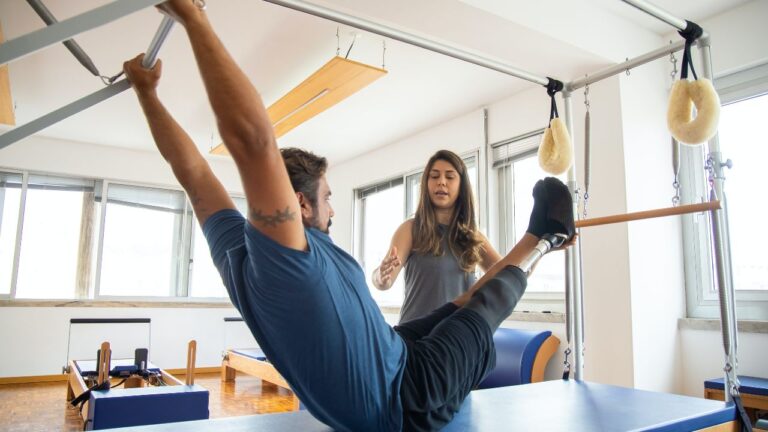This article is also available in English
필라테스 스튜디오를 오픈하고 싶으신가요? 그렇다면 주저하지 말고 바로 사업 준비를 시작하세요.
최근 세계를 강타한 팬데믹에도 불구하고 피트니스 분야에 대한 수요는 여전히 증가하고 있습니다. 최신 발표된 글로벌 보고서에 따르면 필라테스와 요가 스튜디오의 시장 규모는 2025년까지 약 2억 1천 5백만 달러에 육박할 것으로 예측됩니다.
이러한 세계 시장의 움직임을 차치하더라도 필라테스 사업을 준비하는 것은 첫 고객을 끌어들이는 것만큼이나 무척 어려운 일입니다.
좋은 스튜디오 자리를 임대하고 최고급 피트니스 장비를 갖추는 것은 중요하지만, 단지 이것만으로 스튜디오의 성공을 보장하지 못합니다.
필라테스 및 요가 스튜디오 운영에 대한 풍부한 경험과 조사를 바탕으로 처음 스튜디오를 시작하는 사업자가 유념해야 할 사항에 대해 정리해 보았습니다. 필라테스 스튜디오 창업을 위해 반드시 알아야 할 일곱 가지 사안과 그와 관련된 놀라운 팩트를 다음 본문에서 확인하시기 바랍니다.
1. 필라테스 스튜디오 사업 계획서 작성
필라테스를 가르치는데 누구보다 자신감 넘치는 당신, 뛰어난 교습 능력이 스튜디오의 성공을 판가름할 거라 자신하시나요? 절대 그렇지 않습니다.
필라테스 스튜디오 시작하기 위해서는 실질적으로 필라테스 감각보다 사업적 마인드가 더 우선시됩니다.
즉, 스튜디오와 관련된 어떠한 결정을 내리기에 앞서 철저한 사업 계획과 사업 초기의 자금 조달 방식을 숙고해 결정하는 일이 먼저 이루어져야 합니다. 최신 캐딜락과 리포머 구매를 알아보는 것은 그다음 일입니다.
현실적인 재정 계획을 갖추어야 차후 심각한 재정난으로 인해 필라테스 스튜디오를 접어야 하는 사태에 이르지 않을 수 있습니다.
재정 계획에 반드시 포함해야 하는 사항:
- 전체 예산
- 예상 시작 비용
- 시장 경쟁자 및 목표 시장 조사
필라테스 스튜디오 사업 계획서를 작성하는 데 조언이 필요하다면 변호사 및 회계사와 상담하는 것부터 시작하시기 바랍니다.
2. 우수 강사 고용
만약 일인 강사로 스튜디오 운영을 시작했고 이후 사업 확장과 더불어 추가 인원을 고용하고 싶다면 실력 있는 필라테스 강사를 물색해야 할 것입니다. 고용된 강사는 사업자를 대신해 브랜드 가치를 고객에게 전달하고, 그 가치에 만족한 고객은 사업 확장에 견인차 구실을 할 것이기 때문입니다.
강사 자격 판단을 위해서는 기본적으로 요구되는 실력을 검증해야 하는데, 가령 수강생의 요청에 맞춰 수업 내용이나 수업 방식을 적절히 변경할 수 있는지가 실력을 가늠하는 한 기준이 될 수 있습니다. 그러므로 고용하려는 강사가 충분한 경험을 갖추고 공신력 있는 기관에서 자격을 취득한 것이지 반드시 확인하시기 바랍니다.

3. 적절한 가격 책정
다음으로 고려할 사항은 가격 구조와 지역 인구 통계입니다. 가격은 고객에게 가장 민감하게 작용하는 요소로 새로 오픈한 스튜디오의 성패를 가르는 요인이 될 수 있습니다.
장비를 사용하는 부티크 필라테스 스튜디오의 경우 대규모 그룹 매트 수업보다 수강료를 조금 더 높게 책정할 수 있습니다. 보통 부티크 스튜디오의 수업은 소규모로 진행되기 때문에 헬스장의 대규모 그룹 강습보다 집중도가 높고 개별적인 교정을 받을 기회가 더 많기 때문입니다.
지역 역시 가격 책정에 큰 영향을 미칩니다. 이는 비 도심 지역의 필라테스 수강생이 도심 부근 수강생에 비해 최상위 가격의 수업을 지불할 의사가 적다는 통계를 통해 알 수 있습니다.
같은 지역 내 경쟁 스튜디오를 조사하여 적절한 수강료를 책정할 수도 있고 또는 타지역에 있는 본인의 스튜디오와 유사한 스튜디오들의 수강료 평균을 구해 반영할 수도 있습니다. 후자의 경우 직접적인 경쟁상대가 아니므로 업주가 수강료 공개를 꺼릴 확률이 낮습니다.
이렇게 취합한 정보를 바탕으로 본인의 스튜디오가 제공하는 서비스 가치를 공정하게 반영하고 경쟁력 있는 방식으로 수강료를 책정합니다.
4. 보험 가입
보험 가입은 필라테스 스튜디오를 오픈하는 과정에서 가장 우선시 되어야 할 사항입니다. 보험에 가입되어 있지 않다면 본인 또는 동료 강사의 수업 중에 발생할 수 있는 사고에 대한 의료비 및 손해 배상 비용을 직접 부담해야 하기 때문입니다.
교습 자격을 갖춘 모든 필라테스 강사는 기본적으로 "전문 배상 보험"에 가입된 상태여야 하지만, 언제나 고용주가 직접 확인하는 것이 바람직합니다. 만일의 사태로 인한 복잡하고 피곤한 법적 다툼을 피하려면 스튜디오가 고용하거나 초빙한 강사가 보험에 가입한 상태인지 반드시 확인하셔야 합니다. 사업자 본인도 강습을 한다면 보험을 최신 상태로 유지하는 것이 좋습니다.
5. 사업체 및 세금 등록
사업체를 설립하고 스튜디오를 운영할 수 있는 올바른 허가를 받았는지 확인합니다. 그런 다음 자격에 맞는 세금을 등록합니다. 이 모든 절차가 전문적이고 부담스럽게 느껴질 수 있지만 새 스튜디오를 시작하는데 반드시 거쳐야 하는 단계입니다.
또한 소송을 비롯한 예상치 못한 문제가 발생할 경우 스튜디오에 보험이 적용되고 모든 개인 자산이 보호되는지 보험사와 반드시 확인해야 합니다.
납세 자격과 관련해선 스튜디오를 법인 사업으로 등록하기 위한 법적인 요구 사항은 없습니다. 그러나 세율에 관해선 개인 사업자와 차이가 있는데, 개인 사업자의 경우 매출액이 증가하면 과세율이 급격히 높아지는 반면(5억 이상의 경우 42%) 법인은 상대적으로 낮은 세율로 일정 매출액까지 고정됩니다(200억 상한으로 20%). 그러나 법인은 법인 계좌에서 자금 인출 시 6~42%에 이르는 소득세를 추가로 납부해야 한다는 부담이 있습니다.
따라서, 개인 사업과 법인 사이의 선택은 사업 확장 가능성, 세율, 소득의 귀속 문제를 충분히 고려한 뒤 결정하는 것이 좋습니다.

6. 마케팅 전략 수립
오늘날 필라테스 브랜딩과 스튜디오 웹사이트 제작은 그저 광범위한 마케팅 전략의 시작에 불과합니다. 스튜디오를 성공적으로 오픈하고 이후에도 꾸준히 고객을 유치하려면 명확한 마케팅 전략을 수립해야만 합니다.
구체적인 전략과 예시는 다음과 같습니다:
- 소개 마케팅:소개 마케팅이란 스튜디오의 우수한 서비스에 만족한 고객이 가족, 친구 및 지인에게 스튜디오를 소개하여 새로운 고객을 불러들이는 것을 의미합니다. 고객의 자세가 곧아지고 몸매가 좋아 보이기 시작하면 주변 사람 역시 먼저 비결을 묻기 시작하거나 스튜디오를 소개를 부탁할 것입니다. 그리고 필라테스가 과연 효과 있느냐는 질문은 쏙 들어갈 것입니다.
- 콘텐츠 마케팅: 콘텐츠 마케팅은 인포그래픽, 블로그, 교육용 동영상 등 다양한 양식과 형태로 제공됩니다. 각종 소셜 플랫폼에서 콘텐츠 마케팅을 활용하여 기존 및 잠재고객의 참여를 장려하고 브랜드 정체성을 구축하며 결과적으로 더 많은 고객을 유치합니다.
- 소셜 미디어:소셜 미디어상의 활발하고 꾸준한 활동으로 기존 고객과는 더 가까워지고 잠재고객과는 새로운 관계를 맺어 끌어들입니다. 마케터는 또한 SNS를 다양한 콘텐츠 마케팅 및 이벤트 행사를 홍보하는 장으로 이용할 수 있습니다.
- 할인/특별 행사: 잠재 고객이 스튜디오에 방문하여 단체 수업 및 일대일 수업을 직접 체험해 볼 기회를 제공합니다. 무료 수업, 무료 일대일 세션, 수강료 할인, 오픈 데이 등 고객 참여와 관련도 모든 것을 기획해 볼 수 있습니다.
- 지역 네트워킹: 지역 네트워킹은 다른 마케팅 기법에 비해 다소 구식처럼 보이지만, 새로운 필라테스 사업을 위해 시도해 볼 수 있는 매우 효과적인 전략입니다. 결국 대부분의 고객은 사업체가 위치한 지역 내에서 찾아오기 때문입니다. 인근 기업, 학교 및 교회에 직접 찾아가 자신의 새 스튜디오를 적극적으로 홍보하세요.
7. 예약 관리 소프트웨어 사용
사업 초기 단계에서 예약 관리 소프트웨어에 투자하는 것이 지나치다고 생각되시나요? 절대 그렇지 않습니다!
최첨단 플랫폼인 Ruoom과 같은 사업 관리 소프트웨어를 스튜디오 운영 초기 단계부터 도입해 사용하면 관리자는 단순하고 소모적인 작업에서 벗어나 필라테스 수업과 같은 더 중요한 업무에 집중할 수 있습니다.
스튜디오 홈페이지에 Ruoom과 같은 소프트웨어를 통합하면 결제 및 예약 시스템을 간소화 할 수 있습니다. 따라서 학생은 원하는 수업이 생겼을 때 모바일이나 컴퓨터를 통해 원격으로 쉽게 수업을 예약할 수 있고, 이는 예전처럼 번거로운 이메일과 청구서가 오가는 동안 고객이 변심하는 상황을 피할 수 있습니다. 이렇듯, 타이밍은 매출 증대의 핵심입니다.
시작부터 이와 같은 프로세스를 갖추면 시간이 지남에 따라 사업 효율성과 확장성이 빠르게 향상됩니다.
이러한 이점 외에도, Ruoom은 중소기업을 비롯한 모든 규모의 사업체에서 물리적 공간을 효율적으로 사용할 수 있도록 하는 특허 기능을 갖추고 있습니다. 이 기술은 팬데믹 이후 기본 수칙이 된 사회적 거리 두기 및 스튜디오의 한정된 공간 활용에 유용하게 쓰입니다.
필라테스 스튜디오 창업 방법: 핵심 정리
필라테스 스튜디오 창업은 즐거운 일이지만 때로는 벅찰 수 있습니다. 준비 과정에서 흥미를 잃지 않고 스트레스를 줄여야 할 때는 애초에 이 모험을 시작한 이유를 상기하고 동기를 다잡으세요.
앞서 정리한 일곱 가지를 갖추어 개인 또는 업무적 리스크를 최소화하세요. 그 이후 여유를 갖고 필라테스 수련과 함께 과정을 즐기세요!

